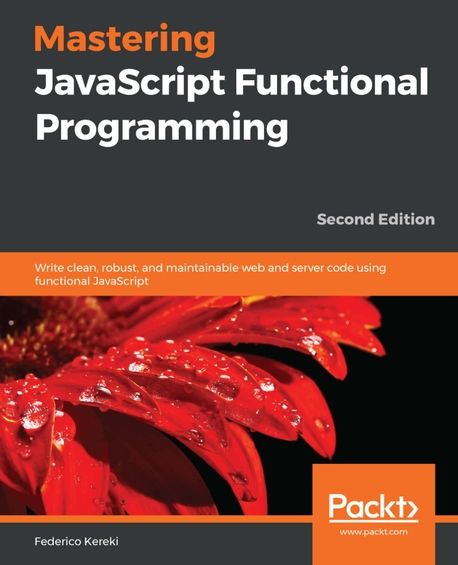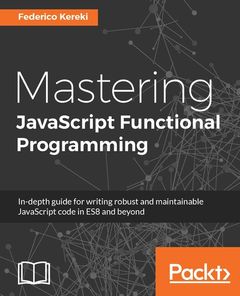Mastering JavaScript Functional Programming Second Edition
2020년 01월 24일 출간
- eBook 상품 정보
- 파일 정보 PDF (6.62MB)
- ISBN 9781839217425
- 지원기기 교보eBook App, PC e서재, 리더기, 웹뷰어
-
교보eBook App
듣기(TTS) 가능
TTS 란?텍스트를 음성으로 읽어주는 기술입니다.
- 전자책의 편집 상태에 따라 본문의 흐름과 다르게 텍스트를 읽을 수 있습니다.
- 이미지 형태로 제작된 전자책 (예 : ZIP 파일)은 TTS 기능을 지원하지 않습니다.
PDF 필기가능 (Android, iOS)

쿠폰적용가 15,300원
10% 할인 | 5%P 적립이 상품은 배송되지 않는 디지털 상품이며,
교보eBook앱이나 웹뷰어에서 바로 이용가능합니다.
카드&결제 혜택
- 5만원 이상 구매 시 추가 2,000P
- 3만원 이상 구매 시, 등급별 2~4% 추가 최대 416P
- 리뷰 작성 시, e교환권 추가 최대 200원
작품소개
이 상품이 속한 분야
▶Book Description
Functional programming is a paradigm for developing software with better performance. It helps you write concise and testable code. To help you take your programming skills to the next level, this comprehensive book will assist you in harnessing the capabilities of functional programming with JavaScript and writing highly maintainable and testable web and server apps using functional JavaScript.
This second edition is updated and improved to cover features such as transducers, lenses, prisms and various other concepts to help you write efficient programs. By focusing on functional programming, you'll not only start to write but also to test pure functions, and reduce side effects. The book also specifically allows you to discover techniques for simplifying code and applying recursion for loopless coding. Gradually, you'll understand how to achieve immutability, implement design patterns, and work with data types for your application, before going on to learn functional reactive programming to handle complex events in your app. Finally, the book will take you through the design patterns that are relevant to functional programming.
By the end of this book, you'll have developed your JavaScript skills and have gained knowledge of the essential functional programming techniques to program effectively.
▶What You Will Learn
-Simplify JavaScript coding using function composition, pipelining, chaining, and transducing
-Use declarative coding as opposed to imperative coding to write clean JavaScript code
-Create more reliable code with closures and immutable data
-Apply practical solutions to complex programming problems using recursion
-Improve your functional code using data types, type checking, and immutability
-Understand advanced functional programming concepts such as lenses and prisms for data access
▶Key Features
-Explore this second edition updated to cover features like async functions and transducers, as well as functional reactive programming
-Enhance your functional programming (FP) skills to build web and server apps using JavaScript
-Use FP to enhance the modularity, reusability, and performance of apps
▶Who This Book Is For
This book is for JavaScript developers who want to enhance their programming skills and build efficient web applications. Frontend and backend developers who use various JavaScript frameworks and libraries like React, Angular, or Node.js will also find the book helpful. Working knowledge of ES2019 is required to grasp the concepts covered in the book easily.
- Chapter 1: Becoming Functional - Several Questions
- Chapter 2: Thinking Functionally - A First Example
- Chapter 3: Starting Out with Functions - A Core Concept
- Chapter 4: Behaving Properly - Pure Functions
- Chapter 5: Programming Declaratively - A Better Style
- Chapter 6: Producing Functions - Higher-Order Functions
- Chapter 7: Transforming Functions - Currying and Partial Application
- Chapter 8: Connecting Functions - Pipelining and Composition
- Chapter 9: Designing Functions - Recursion
- Chapter 10: Ensuring Purity - Immutability
- Chapter 11: Implementing Design Patterns - The Functional Way
- Chapter 12: Building Better Containers - Functional Data Types
▶What this book covers
In this book, we'll cover FP in a practical way; though, at times, we will mention some theoretical points:
- Chapter 1, Becoming Functional ? Several Questions, discusses FP, gives reasons for its usage, and lists the tools that you'll need to take advantage of the rest of the book.
- Chapter 2, Thinking Functionally ? A First Example, will provide the first example of FP by considering a common web-related problem and going over several solutions, to finally center on a functional solution.
- Chapter 3, Starting Out with Functions ? A Core Concept, will go over the central concept of FP, that is, functions, and the different options available in JavaScript.
- Chapter 4, Behaving Properly ? Pure Functions, will consider the concept of purity and pure functions, and demonstrate how it leads to simpler coding and easier testing.
- Chapter 5, Programming Declaratively ? A Better Style, will use simple data structures to show how to produce results that work not in an imperative way, but in a declarative fashion.
- Chapter 6, Producing Functions ? Higher-Order Functions, will deal with higher-order functions, which receive other functions as parameters and produce new functions as results.
- Chapter 7, Transforming Functions ? Currying and Partial Application, will explore some methods for producing new and specialized functions from earlier ones.
- Chapter 8, Connecting Functions ? Pipelining and Composition, will show the key concepts regarding how to build new functions by joining previously defined ones.
- Chapter 9, Designing Functions ? Recursion, will look at how a key concept in FP, recursion, can be applied to designing algorithms and functions.
- Chapter 10, Ensuring Purity ? Immutability, will present some tools that can help you to work in a pure fashion by providing immutable objects and data structures.
- Chapter 11, Implementing Design Patterns ? The Functional Way, will show how several popular OOP design patterns are implemented (or not needed!) when you program in FP ways.
- Chapter 12, Building Better Containers ? Functional Data Types, will explore some more highlevel functional patterns, introducing types, containers, functors, monads, and several other more advanced FP concepts.
-I have tried to keep the examples in this book simple and down to earth because I want to focus on the functional aspects and not on the intricacies of this or that problem. Some programming texts are geared toward learning, say, a given framework, and then work on a given problem, showing how to fully work it out with the chosen tools. (In fact, at the very beginning of planning for this book, I entertained the idea of developing an application that would use all the FP things I had in mind, but there was no way to fit all of that within a single project. Exaggerating a bit, I felt like an MD trying to find a patient on whom to apply all of his medical knowledge and treatments!) So, I have opted to show plenty of individual techniques, which can be used in multiple situations. Rather than building a house, I want to show you how to put the bricks together, how to wire things up, and so on, so that you will be able to apply whatever you need, as you see fit.
▶ Preface
In computer programming, paradigms abound. Some examples include imperative programming, structured (goto-less) programming, object-oriented programming (OOP), aspect-oriented programming, and declarative programming. Lately, there has been renewed interest in a particular paradigm that can arguably be considered to be older than most (if not all) of the cited ones―Functional Programming (FP). FP emphasizes writing functions and connecting them in simple ways to produce a more understandable and more easily tested code. Thus, given the increased complexity of today's web applications, it's logical that a safer, cleaner way of programming would be of interest.
This interest in FP comes hand in hand with the evolution of JavaScript. Despite its somewhat hasty creation (reportedly managed in only 10 days, in 1995, by Brendan Eich at Netscape), today it's a standardized and quickly growing language, with features more advanced than most other similarly popular languages. The ubiquity of the language, which can now be found in browsers, servers, mobile phones, and whatnot, has also impelled interest in better development strategies. Also, even if JavaScript wasn't conceived as a functional language by itself, the fact is that it provides all the features you'd require to work in that fashion, which is another plus.
It must also be said that FP hasn't been generally applied in industry, possibly because it has a certain aura of difficulty, and it is thought to be theoretical rather than practical, even mathematical, and possibly uses vocabulary and concepts that are foreign to developers―for example, functors? Monads? Folding? Category theory? While learning all this theory will certainly be of help, it can also be argued that even with zero knowledge of the previous terms, you can understand the tenets of FP, and see how to apply it in your own programming.
FP is not something that you have to do on your own, without any help. There are many libraries and frameworks that incorporate, in greater or lesser degrees, the concepts of FP. Starting with jQuery (which does include some FP concepts), passing through Underscore and its close relative, Lodash, or other libraries such as Ramda, and getting to more complete web development tools such as React and Redux, Angular, or Elm (a 100% functional language, which compiles into JavaScript), the list of functional aids for your coding is ever growing.
Learning how to use FP can be a worthwhile investment, and even though you may not get to use all of its methods and techniques, just starting to apply some of them will pay dividends in better code. You need not try to apply all of FP from the start, and you need not try to abandon every non-functional feature in the language either. JavaScript assuredly has some bad features, but it also has several very good and powerful ones. The idea is not to throw away everything you've learned and use and adopt a 100% functional way; rather, the guiding idea is evolution, not revolution. In that sense, it can be said that what we'll be doing is not FP, but rather Sorta Functional Programming (SFP), aiming for a fusion of paradigms.
A final comment about the style of the code in this book―it is quite true that there are several very good libraries that provide you with FP tools: Underscore, Lodash, Ramda, and more are counted among them. However, I preferred to eschew their usage, because I wanted to show how things really work. It's easy to apply a given function from some package or other, but by coding everything out (a vanilla FP, if you wish), it's my belief that you get to understand things more deeply. Also, as I will comment in some places, because of the power and clarity of arrow functions and other features, the pure JavaScript versions can be even simpler to understand!
인물정보
저자(글) Federico Kereki
Federico Kereki is a Uruguayan systems engineer, with a master's degree in education, and over 30 years' experience as a consultant, system developer, university professor, and writer. He is currently a subject matter expert at Globant, and he has taught CS courses at Universidad de la Republica, Universidad ORT Uruguay, and Universidad de la Empresa.
이 상품의 총서
Klover리뷰 (0)
- - e교환권은 적립일로부터 180일 동안 사용 가능합니다.
- - 리워드는 5,000원 이상 eBook, 오디오북, 동영상에 한해 다운로드 완료 후 리뷰 작성 시 익일 제공됩니다. (2024년 9월 30일부터 적용)
- - 리워드는 한 상품에 최초 1회만 제공됩니다.
- - sam 이용권 구매 상품 / 선물받은 eBook은 리워드 대상에서 제외됩니다.
- 도서나 타인에 대해 근거 없이 비방을 하거나 타인의 명예를 훼손할 수 있는 리뷰
- 도서와 무관한 내용의 리뷰
- 인신공격이나 욕설, 비속어, 혐오 발언이 개재된 리뷰
- 의성어나 의태어 등 내용의 의미가 없는 리뷰
구매 후 리뷰 작성 시, e교환권 100원 적립
문장수집
- 구매 후 90일 이내에 문장 수집 등록 시 e교환권 100원을 적립해 드립니다.
- e교환권은 적립일로부터 180일 동안 사용 가능합니다.
- 리워드는 5,000원 이상 eBook에 한해 다운로드 완료 후 문장수집 등록 시 제공됩니다. (2024년 9월 30일부터 적용)
- 리워드는 한 상품에 최초 1회만 제공됩니다.
- sam 이용권 구매 상품 / 선물받은 eBook / 오디오북·동영상 상품/주문취소/환불 시 리워드 대상에서 제외됩니다.
구매 후 문장수집 작성 시, e교환권 100원 적립
신규가입 혜택 지급이 완료 되었습니다.
바로 사용 가능한 교보e캐시 1,000원 (유효기간 7일)
지금 바로 교보eBook의 다양한 콘텐츠를 이용해 보세요!

- 구매 후 90일 이내 작성 시, e교환권 100원 (최초1회)
- 리워드 제외 상품 : 마이 > 라이브러리 > Klover리뷰 > 리워드 안내 참고
- 콘텐츠 다운로드 또는 바로보기 완료 후 리뷰 작성 시 익일 제공
가장 와 닿는 하나의 키워드를 선택해주세요.
총 5MB 이하로 jpg,jpeg,png 파일만 업로드 가능합니다.
신고 사유를 선택해주세요.
신고 내용은 이용약관 및 정책에 의해 처리됩니다.
허위 신고일 경우, 신고자의 서비스 활동이 제한될 수
있으니 유의하시어 신중하게 신고해주세요.
이 글을 작성한 작성자의 모든 글은 블라인드 처리 됩니다.
구매 후 90일 이내 작성 시, e교환권 100원 적립
eBook 문장수집은 웹에서 직접 타이핑 가능하나, 모바일 앱에서 도서를 열람하여 문장을 드래그하시면 직접 타이핑 하실 필요 없이 보다 편하게 남길 수 있습니다.
차감하실 sam이용권을 선택하세요.
차감하실 sam이용권을 선택하세요.
선물하실 sam이용권을 선택하세요.
-
보유 권수 / 선물할 권수0권 / 1권
-
받는사람 이름받는사람 휴대전화
- 구매한 이용권의 대한 잔여권수를 선물할 수 있습니다.
- 열람권은 1인당 1권씩 선물 가능합니다.
- 선물한 열람권이 ‘미등록’ 상태일 경우에만 ‘열람권 선물내역’화면에서 선물취소 가능합니다.
- 선물한 열람권의 등록유효기간은 14일 입니다.
(상대방이 기한내에 등록하지 않을 경우 소멸됩니다.) - 무제한 이용권일 경우 열람권 선물이 불가합니다.
첫 구매 시 교보e캐시 지급해 드립니다.

- 첫 구매 후 3일 이내 다운로드 시 익일 자동 지급
- 한 ID당 최초 1회 지급 / sam 이용권 제외
- 구글바이액션을 통해 교보eBook 구매 이력이 없는 회원 대상
- 교보e캐시 1,000원 지급 (유효기간 지급일로부터 7일)






